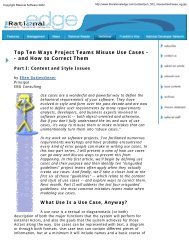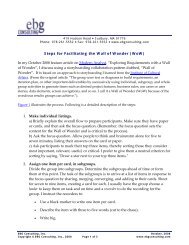Workshop Tools for Filtering Using The Sieve ... - EBG Consulting
Workshop Tools for Filtering Using The Sieve ... - EBG Consulting
Workshop Tools for Filtering Using The Sieve ... - EBG Consulting
You also want an ePaper? Increase the reach of your titles
YUMPU automatically turns print PDFs into web optimized ePapers that Google loves.
<strong>Workshop</strong> <strong>Tools</strong> <strong>for</strong> <strong>Filtering</strong> <strong>Using</strong> <strong>The</strong> <strong>Sieve</strong> Collaboration Pattern<br />
Reference Chapter 9 in<br />
Requirements by Collaboration by Ellen Gottesdiener, Addison-Wesley, 2002.<br />
<strong>The</strong> following list describes tools that can help you filter user requirements. Some of these tools<br />
are listed in the section “<strong>The</strong> <strong>Sieve</strong>,” which describes a collaboration pattern that is useful <strong>for</strong><br />
filtering requirements (or any set of items). References are listed in the book’s Bibliography.<br />
Remember: After you apply any of these tools in a workshop, use the group’s decision-making<br />
process to reach closure.<br />
Tool<br />
Predefined prioritization and ranking scales<br />
Brief Description Scales or schemes <strong>for</strong> evaluating options defined by a standards body<br />
or another organization. Examples include IEEE (essential,<br />
conditional, optional); DuBLIN (definitely have, better have, like to<br />
have, not have); MoSCoW (must, should, could, won’t); high,<br />
medium, low; critical, important, useful.<br />
Uses and Tips Use <strong>for</strong> prioritizing and ranking scope-level or high-level user<br />
requirements such as events, use cases, and business policies. Write a<br />
precise definition of each element in the scale, send it with the agenda,<br />
and review it be<strong>for</strong>e applying.<br />
Further Reference (IEEE, 1998; Stapleton, 1997)<br />
Tool<br />
Multivoting<br />
Brief Description A technique <strong>for</strong> taking several votes on a list of items in which<br />
participants are given a fixed number of choices each time they vote.<br />
You then distribute the number of votes using a predetermined method<br />
such as<br />
• N/3 (total number of items on the list divided by 3)<br />
• N/3 +1<br />
• Cast five draws<br />
• Choose all you like<br />
Uses and Tips Use <strong>for</strong> selecting items from a long list. Participants can use dots or<br />
checkmarks to indicate votes. Be<strong>for</strong>e voting, establish rules about the<br />
maximum number of votes allowed per item and conduct a brief<br />
discussion about each item. Take multiple passes at the list.<br />
Optionally, use colored dots <strong>for</strong> prioritizing the votes.<br />
Further Reference (Bens, 2000; Kearny, 1995)<br />
Copyright by Ellen Gottesdiener, 2002 www.ebgconsulting.com 1<br />
Practitioner assets <strong>for</strong> Requirements by Collaboration, by Ellen Gottesdiener, Addison-Wesley, 2002<br />
Permission is granted to use, modify and distribute this document
Tool<br />
Brief Description<br />
Uses and Tips<br />
Further Reference<br />
Cost-risk-value matrix<br />
An analytic method of assigning relative priorities to a set of<br />
requirements based on the attributes cost, risk, and value.<br />
Depending on the software product you’re building, risk can involve<br />
human life, regulatory exposure, technical risks, or risks associated<br />
with organizational or industry change. Value includes the potential<br />
income from the software or benefits gained from operational<br />
efficiencies.<br />
As you uncover your requirements, assign these attributes to each one.<br />
For example, in a use case requirements workshop, review the<br />
assignments, adjust them as needed, and then use the rankings to<br />
<strong>for</strong>mally prioritize the requirements.<br />
(Wiegers, 1999) For a spreadsheet to help you use this techniques, see<br />
“Requirements Prioritization Worksheet” provided by Karl Wiegers,<br />
the technique’s author:<br />
http://www.processimpact.com/goodies.shtml#reqs)<br />
Tool<br />
Voice of the customer<br />
Brief Description A technique within the quality function deployment (QFD)<br />
methodology that categorizes customer needs as expectors<br />
(characteristics taken <strong>for</strong> granted by customers that would disappoint<br />
them if not present), unspokens (characteristics not stated by the<br />
customers but that would upset them if not present), spokens (normal<br />
requirements customers will tell you about), or delighters<br />
(requirements that are exciting to the customer but would have little<br />
adverse effect if they were not present).<br />
Uses and Tips Use both <strong>for</strong> generating and <strong>for</strong> analyzing requirements such as use<br />
cases.<br />
Further Reference (Cohen, 1995; Pardee, 1996)<br />
Copyright by Ellen Gottesdiener, 2002 www.ebgconsulting.com 2<br />
Practitioner assets <strong>for</strong> Requirements by Collaboration, by Ellen Gottesdiener, Addison-Wesley, 2002<br />
Permission is granted to use, modify and distribute this document
Tool<br />
Brief Description<br />
Uses and Tips<br />
Further Reference<br />
$100 test<br />
A variant QFD matrix that metaphorically allows customers and users<br />
to spend money on requirements. Customers and users must distribute<br />
$100 among requirements such as a list of use cases. <strong>The</strong> total amount<br />
<strong>for</strong> each requirement is summed, and an importance weighting is<br />
assigned (the total dollars spent by all participants divided by the<br />
number of participants).<br />
Use to allow customers and users to “put their money where their<br />
mouth is.” Key customers and users must be present. Follow up with<br />
discussion or a <strong>for</strong>mal ranking scheme. This approach ranks only<br />
importance. Other benefits or barriers, such as market demand,<br />
technical difficulty, architectural dependency, or project risk, are not<br />
included and should also be analyzed.<br />
Customers can write dollar amounts on the matrix posted on the wall,<br />
or tack play money into the matrix.<br />
n/a<br />
Tool<br />
Nominal group technique<br />
Brief Description A technique that integrates anonymous polling <strong>for</strong> both generating and<br />
selecting items in a group. In the selection portion, participants<br />
privately rank their choices. Each then explains her rankings; each<br />
speaker has the same amount of time, and there is no discussion or<br />
debate. This is followed by a second round of private ranking, after<br />
which preferences are recorded and weighted.<br />
Uses and Tips Use when one or a few items must be selected in priority order, the<br />
choices are well understood, and there are participants at different<br />
levels in the organization whose decisions are equally needed.<br />
Further Reference (Bens, 2000; Ritter and Brassard, 1994)<br />
Tool<br />
Pairwise prioritization matrix<br />
Brief Description A matrix <strong>for</strong> comparing each option in a long list; participants evaluate<br />
them in pairs until all the choices are reviewed. This results in<br />
individual as well as group rank-ordered lists.<br />
Uses and Tips Use to help participants to assess each option individually against<br />
another; useful <strong>for</strong> ranking a list of six or more items. A variation is to<br />
take a second pass as a whole group after individual scores are tallied<br />
and shared.<br />
Further Reference (Kearny, 1995)<br />
Copyright by Ellen Gottesdiener, 2002 www.ebgconsulting.com 3<br />
Practitioner assets <strong>for</strong> Requirements by Collaboration, by Ellen Gottesdiener, Addison-Wesley, 2002<br />
Permission is granted to use, modify and distribute this document
Tool<br />
Criteria grid<br />
Brief Description A matrix is created that allows participants to rate options against an<br />
agreed-upon list of criteria. Examples of criteria are as follows: the<br />
impact on an organization’s objectives, the benefit to customer service<br />
goals, the effect on organizational change, the effect on utilization of<br />
resources, and the time to implement. Participants use numeric ranking<br />
scales <strong>for</strong> each option.<br />
Uses and Tips A criteria grid is useful when the group has a set of clear and agreedupon<br />
criteria, when one or a few items in priority order must be<br />
selected, and when participants like to use analytical tools and have<br />
sufficient knowledge of the choices. Agree upon and clearly define<br />
each criterion and the ranking scales be<strong>for</strong>e using the grid. Use a short<br />
list of criteria (three to five). A variation is to use an x in the cell to<br />
indicate whether the option meets the criteria rather than a numerical<br />
scale.<br />
Complex variations of multi-criteria grids borrow from decision<br />
analysis and decision modeling methodologies and require the<br />
separation of benefits and costs and then their integration after each of<br />
the options is weighted separately.<br />
Further Reference (Bens, 2000; Kearney, 1995; Ritter and Brassard, 1994)<br />
Tool<br />
Weighted criteria grid<br />
Brief Description A variation of the criteria grid in which each of the criteria is assigned<br />
a weight. This permits options that satisfy more important criteria to<br />
be prioritized higher. For example, criteria such as “speed to<br />
implement” might be twice as important as the other criteria, so<br />
ranking <strong>for</strong> that criteria would be multiplied by 2.<br />
Uses and Tips Use whole numbers <strong>for</strong> weights, such as 1, 2, or 4. Items with a weight<br />
of 2 are twice as important as those with a weight of 1, and those with<br />
a weight of 4 are twice as important as those with a weight of 2.<br />
Further Reference (Bens, 2000)<br />
Tool<br />
Brief Description<br />
Uses and Tips<br />
Ef<strong>for</strong>t-Impact grid<br />
A grid <strong>for</strong> plotting choices along gradients of ef<strong>for</strong>t and impact.<br />
Use when the top criteria are ef<strong>for</strong>t and impact and there are a small<br />
number of items to consider. It can also be used to determine which<br />
Copyright by Ellen Gottesdiener, 2002 www.ebgconsulting.com 4<br />
Practitioner assets <strong>for</strong> Requirements by Collaboration, by Ellen Gottesdiener, Addison-Wesley, 2002<br />
Permission is granted to use, modify and distribute this document
projects to undertake first. Decide be<strong>for</strong>ehand how you will treat each<br />
quadrant of the grid. For example, options that are easy to do and have<br />
maximum impact would be prioritized highest, those that are difficult<br />
to do and have minimum impact are eliminated, items that are easy but<br />
with minimum impact are prioritized to be implemented as resources<br />
allow, and items that are difficult to do but have a high impact are<br />
selected <strong>for</strong> detailed action planning in a follow-up workshop.<br />
Further Reference (Bens, 2000, Grove Consultants, 1994)<br />
Tool<br />
Portfolio matrix<br />
Brief Description A matrix with four sections in which participants map items along a<br />
lifecycle metaphor—sow, grow, harvest, and plow—to help decide<br />
where to allocate resources. For example, the “plow” category means<br />
that the option needs to be eliminated and resources reallocated to<br />
other choices. “Plow” might have criteria such as not aligned with<br />
vision, uses critical resources, and fails to generate sufficient customer<br />
justification.<br />
Uses and Tips Use <strong>for</strong> reallocating user requirements to match strategies, analyzing<br />
current resource allocation, or prioritizing projects. Clarify each life<br />
cycle’s meaning and determine its criteria be<strong>for</strong>e applying them to the<br />
options.<br />
Further Reference (Grove Consultants, 1997)<br />
Tool<br />
Brief Description<br />
Uses and Tips<br />
Further Reference<br />
Ask why five times<br />
A directed thinking technique <strong>for</strong> understanding the root cause of<br />
something such as a goal, need, or want. For each item, such as a use<br />
case and its related requirements, ask, “Why do you need this”<br />
Participants respond, and then you ask “why” to each answer<br />
successively until you have asked “why” five times.<br />
Be sure that each requirement is well understood be<strong>for</strong>e using this<br />
technique; ideally, direct users (and not surrogate users) participate.<br />
When the last question yields an answer that directly relates to a<br />
project’s goals and objectives, that requirement should be prioritized<br />
higher than others that less directly promote goals and objectives.<br />
n/a<br />
Copyright by Ellen Gottesdiener, 2002 www.ebgconsulting.com 5<br />
Practitioner assets <strong>for</strong> Requirements by Collaboration, by Ellen Gottesdiener, Addison-Wesley, 2002<br />
Permission is granted to use, modify and distribute this document















